Hungarians: Difference between revisions
Iadrian yu (talk | contribs) →Folklore and Landscapes: This picture was added by a Sock user, let it remain for now, but there is no data that this Cathedral is Hungarian Catholic |
added some sources for nationalist trollls who assert that a church consecrated to Saint Elizabeth of Hungary can't be an example of Hungarian architecture. |
||
| Line 243: | Line 243: | ||
File:Hungarian tresure Galgoci.jpg|The "Tree of Life" on an ancient Magyar sabertache (tarsoly) plate |
File:Hungarian tresure Galgoci.jpg|The "Tree of Life" on an ancient Magyar sabertache (tarsoly) plate |
||
File:Oföldeákcivertan1.jpg|Hungarian Church at Óföldeák |
File:Oföldeákcivertan1.jpg|Hungarian Church at Óföldeák |
||
File:Kosice - St. Elisabeth Cathedral 1.JPG|Gothic church of [[Košice|Kassa]] (today's [[Košice]], [[Slovakia]])<ref>{{cite book|title=The St. Elisabeth cathedral of Košice (A kassai Szent Erzsébet-dóm)|language=Hungarian|first1=Marcell|last1=Jankovics|first2=Gábor|last2=Méry|publisher=Méry Ratio|date=2007}}</ref><ref>{{cite book|title=Royal wives' book - Hungary's queens, royal wives, governors' wives and dukesses (Királynék könyve - Magyarország királynői, királynéi, kormányzónéi és fejedelemasszonyai)|language=Hungarian|page=48|first=János|last=Estók|date=2005|publisher=Helikon}}</ref> |
|||
File:Kosice - St. Elisabeth Cathedral 1.JPG|Gothic church of [[Košice]], [[Slovakia]] |
|||
File:Keszthely - Festetics Castle.jpg|Festetics palace of Keszthely |
File:Keszthely - Festetics Castle.jpg|Festetics palace of Keszthely |
||
</gallery> |
</gallery> |
||
Revision as of 11:45, 30 June 2012
 1st row: Saint Stephen I • Matthias Corvinus • Gábor Bethlen • Béla Bartók 2nd row: Tivadar-K Csontváry • János Bolyai • Loránd Eötvös • József Eötvös 3rd row: Zoltán Kodály • János Arany • István Széchenyi • Francis II Rákóczi | ||
| Total population | ||
|---|---|---|
| c. 14-15 million | ||
| Regions with significant populations | ||
| Neighbours of Hungary | c. 2.2 million | |
| 1,237,746 (2011)[2] | ||
| 458,467 (2011)[3] | ||
| 293,299 (2002)[4] | ||
| 156,566 (2001)[5] | ||
| 40,583 (2001)[6] | ||
| 16,595 (2001)[7] | ||
| 6,243 (2002)[8] | ||
| Rest of Europe | c. 0.3-0.5 million | |
| 120,000 (2004)[9] | ||
| 80,135 (2001) | ||
| 14,672 (2001)[10] | ||
| 6,800 (2001)[11] | ||
| 3,768 (2002)[12] | ||
| 3,328 (2006)[13] | ||
| 2,003 (2002)[14] | ||
| North America | c. 2 million | |
| 1,563,081 (2006)[11] | ||
| 1,050 | ||
| South America | 0.2 - 1 million[11] | |
| 80,000[15] | ||
| 40,000-50,000[16] | ||
| Oceania (AUS / NZL) | 70,000[11] | |
| 67,616[17] | ||
| 1,476 | ||
| Asia | c. 10,000 | |
| 3,029 | ||
| 1,114 | ||
| Africa | 10,000[11] | |
| Languages | ||
| Hungarian | ||
| Religion | ||
| ||
Hungarians, also known as Magyars (Hungarian: magyarok), are a nation and ethnic group who speak Hungarian and are primarily associated with Hungary. There are around 14-15 million Hungarians, of whom 10 million live in today's Hungary (as of 2011).[18] About 2.2 million Hungarians live in areas that were part of the Kingdom of Hungary before the 1918-1920 dissolution of the Austro-Hungarian Monarchy and the Treaty of Trianon, and are now parts of Hungary's seven neighbour countries, especially Romania, Slovakia, Serbia and Ukraine. Significant groups of people with Hungarian ancestry live in various other parts of the world, most of them in the United States, Germany, the United Kingdom, Brazil, Argentina, Chile, Canada and Australia. Unlike the Hungarians living on the former territory of pre-1918-20 Kingdom of Hungary, only some of the ethnic Hungarians in other areas preserve the Hungarian language and traditions. The Hungarians can be classified into several subgroups according to local linguistic and cultural characteristics; subgroups with distinct identities include the Székely, the Csángó, the Palóc, and the Jassic people.
Name
The exonym "Hungarian" is thought to be derived from the Bulgar-Turkic On-Ogur (meaning "ten" Ogurs),[19] which was the name of the Utigur Bulgar tribal confederacy that ruled the eastern parts of Hungary after the Avars, and prior to the arrival of Magyars. The Hungarians must have belonged to the Onogur tribal alliance and it is quite possible they became its ethnic majority.[19] In the Early Middle Ages the Hungarians had many different names as "Ungar" or "Hungarus".[20]
The Hungarian people refer to themselves by the denomination "Magyar", instead of the term "Hungarian", which is used by foreigners.[19]
The "H-" prefix is an addition in Medieval Latin. The medieval Kingdom of Hungary was known in Latin as either Regnum Hungariae or as Regnum Ungariae.
The Hungarian endonym is Magyar. There are several theories about the origin and meaning of the word "Magyar".[citation needed]
Ethnic affiliations and genetic origins
The linguistic heritage of the Hungarians comes from Finno-Ugric peoples. A branch of Uralic speakers migrated from their original homeland near the Ural mountains and settled in various places in eastern Europe, until they conquered the present-day area of Hungary between the 9th and 10th centuries. Genetically, the present-day Hungarian population preserves much of an older European genetic makeup.[21][22] In the Middle Ages, according to genetic and palaeoanthropological studies, the majority of Hungarians showed features of European biological descent.[23][24]
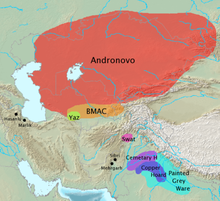
Pre-fourth century AD
During the fourth millennium BC, the Uralic-speaking peoples who were living in the central and southern regions of the Urals split up. Some dispersed towards the west and northwest and came into contact with Iranian speakers who were spreading northwards.[25] From at least 2000 BC onwards, the Ugrian speakers became distinguished from the rest of the Uralic community. Judging by evidence from burial mounds and settlement sites, they interacted with the Andronovo Culture,[26] furthermore, type of Hungarians of the Conquest period shows related features to that of Andronovo people.[27]
Fourth century to c.830 AD
In the fourth and 5th centuries AD, the Magyars moved to the west of the Ural Mountains to the area between the southern Ural Mountains and the Volga River known as Bashkiria (Bashkortostan) and Perm Krai.
In the early 8th century, some of the Magyars moved to the Don River to an area between the Volga, Don and the Seversky Donets rivers.[28] Meanwhile, the descendants of those Magyars who stayed in Bashkiria remained there as late as 1241.
The Magyars around the Don River were subordinates of the Khazar khaganate. Their neighbours were the archaeological Saltov Culture, i.e. Bulgars (Proto-Bulgarians, Onogurs) and the Alans, from whom they learned gardening, elements of cattle breeding and of agriculture. Tradition holds that the Magyars were organized in a confederacy of tribes called hétmagyar (lit. seven Hungarians). The tribes of the hétmagyar were: Jenő, Kér, Keszi, Kürt-Gyarmat, Megyer, Nyék, and Tarján.
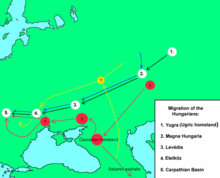 |
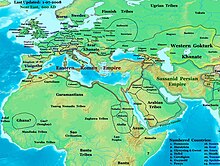 |
 |
| Magyar Migrations, 300-900 AD | Magyar location, 600 AD | Migration to Carpathian Basin, 895-955 (Hungarian: honfoglalás) |
c.830 to c.895
Around 830, a civil war broke out in the Khazar khaganate. As a result, three Kabar tribes[29] of the Khazars joined the Magyars and they moved to what the Magyars call the Etelköz, i.e. the territory between the Carpathians and the Dnieper River (today's Ukraine)[citation needed]. Around 854, the Magyars faced a first attack by the Pechenegs.[28] (According to other sources, the reason for the departure of the Magyars to Etelköz was the attack of the Pechenegs.) Both the Kabars and earlier the Bulgars may have taught the Magyars their Turkic languages. The new neighbours of the Magyars were the Varangians and the eastern Slavs. From 862 onwards, the Magyars (already referred to as the Ungri) along with their allies, the Kabars, started a series of looting raids from the Etelköz to the Carpathian Basin–mostly against the Eastern Frankish Empire (Germany) and Great Moravia, but also against the Balaton principality and Bulgaria.[30]
Entering the Carpathian Basin (after 895)

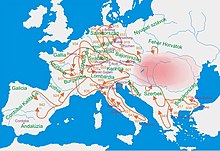



In 895/896, under the leadership of Árpád, some Hungarians crossed the Carpathians and entered the Carpathian Basin. The tribe called Megyer was the leading tribe of the Hungarian alliance that conquered the centre of the basin. At the same time (c.895), due to their involvement in the 894–896 Bulgaro-Byzantine war, Magyars in Etelköz were attacked by Bulgaria and then by their old enemies the Pechenegs. The Bulgarians won the decisive battle of Southern Buh. It is uncertain whether or not those conflicts were the cause of the Hungarian departure from Etelköz.
From the upper Tisza region of the Carpathian Basin, the Hungarians intensified their looting raids across continental Europe. In 900, they moved from the upper Tisza river to Transdanubia (Pannonia)[citation needed], which later became the core of the arising Hungarian state. At the time of the Hungarian migration, the land was inhabited only by a sparse population of Slavs, numbering about 200,000,[28] who were either assimilated or enslaved by the Hungarians.[28]
After the battle of Augsburg (955), the Hungarians stopped their raids against Western Europe.
Many of the Hungarians, however, remained to the north of the Carpathians after 895/896, as archaeological findings suggest (e.g. Polish Przemyśl). They seem to have joined the other Hungarians in 900. There is also a consistent Hungarian population in Transylvania, the Székelys, comprise 40% of the Hungarians in Romania.[31][32] The Székely people's origin, and in particular the time of their settlement in Transylvania, is a matter of historical controversy.
History after 900
Medieval Hungary controlled more territory than medieval France, and the population of medieval Hungary was the third largest of any country in Europe. The Hungarian leader Árpád is believed to have led the Hungarians into the Carpathian Basin in 896. In 907, the Hungarians destroyed a Bavarian army in the Battle of Pressburg and laid the territories of present-day Germany, France and Italy open to Hungarian raids. These raids were fast and devastating. The Hungarians defeated Louis the Child's Imperial Army near Augsburg in 910. From 917 to 925, Hungarians raided through Basle, Alsace, Burgundy, Saxony, and Provence.[33] Magyar expansion was checked at the Battle of Lechfeld in 955. Although the battle at Lechfeld stopped the Hungarian raids against Western Europe, the raids on the Balkan Peninsula continued until 970.[34] Hungarian settlement in the area was approved by the Pope when their leaders accepted Christianity, and Stephen I the Saint (Szent István) was crowned King of Hungary in 1001. The century between the Magyars' arrival from the eastern European plains and the consolidation of the Kingdom of Hungary in 1001 was dominated by pillaging campaigns across Europe, from Dania (Denmark) to the Iberian Peninsula (modern Spain and Portugal).[35] After the country's acceptance into Christian Europe under Stephen I, Hungary served as a bulwark against further invasions from the east and south, especially against the Turks.
At this time, the Hungarian nation numbered between 25,000[36] and 1,000,000 people.[28][37]
The name "Hungarian" has also a wider meaning, as it once referred to all inhabitants of the Kingdom of Hungary irrespective of their ethnicity.[38]
The first accurate measurements of the population of the Kingdom of Hungary including ethnic composition were carried out in 1850–51. There is a debate among Hungarian and non-Hungarian (especially Slovak and Romanian) historians about the possible changes in the ethnic structure throughout history.
Some historians support the theory that the Magyars' proportion in the Carpathian Basin was at an almost constant 80% during the Middle Ages[39][40][41][42][43] – non Magyars numbered hardly more than 20% to 25% of the total population[39] and began to decrease only at the time of the Ottoman conquest,[39][40][43] – reaching as low as around 39% in the end of the 18th century. The decline of the Magyars was due to the constant wars, Ottoman raids, famines and plagues during the 150 years of Ottoman rule.[39][40][43] The main zones of war were the territories inhabited by the Magyars, so the death toll attrited them at a much higher rate than among other nationalities.[39][43] In the 18th century their proportion declined further because of the influx of new settlers from Europe, especially Slovaks, Serbs, Croats, and Germans.[39][40][43][44] Droves of Romanians entered Transylvania during the same period.[40][44][45] As a consequence of the Turkish occupation and the Habsburg colonization policies, the country underwent a great change in ethnic composition.[43] Hungary's population more than tripled to 8 million between 1720 and 1787, however, only 39% of its people were Magyars, who lived primarily in the centre of the country.[39][40][41]
Other historians, particularly Slovak and Romanian ones, tend to argue that the drastic change in the ethnic structure hypothesized by Hungarian historians in fact did not occur. Therefore, the Magyars are supposed to have accounted only for about 30–40%[citation needed] of the Kingdom's population since its establishment. In particular, there is a fierce debate among Magyar and Romanian historians about the ethnic composition of Transylvania through the times; see Origin of the Romanians.
In the 19th century, the proportion of Magyars in the Kingdom of Hungary rose gradually, reaching over 50% by 1900 due to higher natural growth and magyarization. Between 1787 and 1910 number of ethnic Hungarians rose from 2.3 million to 10.2 million due to population explosion, generated by the resettlement of the Great Hungarian Plain and Voivodina by mainly Roman Catholic Hungarian settlers from the northern and western counties of the Kingdom of Hungary. In 1715 (after the Ottoman occupation) the Southern Great Plain was near uninhabited, now has 1.3 million inhabitants, and it's homogeneous with ethnic Hungarians.
Spontaneous assimilation was an important factor, especially among the German and Jewish minorities and the citizens of the bigger towns. On the other hand, about 1.5 million people (of whom about two-thirds were non-Hungarian) left the Kingdom of Hungary between 1890–1910 to escape from poverty.[46]
The years 1918 to 1920 were a turning point in the Magyars' history. By the Treaty of Trianon, the Kingdom had been cut into several parts, leaving only a quarter of its original size. One third of the Magyars became minorities in the neighbouring countries.[47] During the remainder of the 20th century, the Magyar population of Hungary grew from 7.1 million (1920) to around 10.4 million (1980), despite losses during the Second World War and the wave of emigration after the attempted revolution in 1956. The number of Hungarians in the neighbouring countries tended to remain the same or slightly decreased, mostly due to assimilation (sometimes forced; see Slovakization and Romanianization)[48][49][50] and emigration to Hungary (in the 1990s, especially from Transylvania and Vojvodina).
After the "baby boom" of the 1950s (Ratkó era), a serious demographic crisis began to develop in Hungary and its neighbours.[51] The Magyar population reached its maximum in 1980, after which it began to decline. This decline is expected to continue at least until 2050, at which time the population will probably be between 8 and 9 million.[51]
Today, the Magyars represent around 35% of the population of the Carpathian Basin, their number is around 12–13 million. For historical reasons (see Treaty of Trianon), significant Hungarian minority populations can be found in the surrounding countries, most of them in Romania (in Transylvania), Slovakia, Serbia (in Vojvodina). Sizable minorities live also in Ukraine (in Transcarpathia), Croatia (primarily Slavonia) and Austria (in Burgenland). Slovenia is also host to a number of ethnic Hungarians, and Hungarian language has an official status in parts of the Prekmurje region. Today, more than two million ethnic Hungarians live in nearby countries.[52]
There was a referendum in Hungary in December 2004 on whether to grant Hungarian citizenship to Magyars living outside Hungary's borders (i.e. without requiring a permanent residence in Hungary). The referendum failed due to insufficient voter turnout. On May 26, 2010, Hungary's Parliament passed a bill granting dual citizenship to ethnic Hungarians living outside of Hungary. The neighboring countries with sizable Hungarian minority expressed concerns over the legislation[53].
Later influences
Besides the various peoples mentioned above, the Magyars assimilated or were influenced by subsequent peoples arriving in the Carpathian Basin. Among these are the Cumans, Pechenegs, Jazones, Germans and other Western European settlers in the Middle Ages. Vlachs (Romanians) and Slavs have lived together and blended with Magyars since early medieval times. Ottomans, who occupied the central part of Hungary from c.1526 until c.1699, inevitably exerted an influence, as did the various nations (Germans, Slovaks, Serbs, Croats and others) that resettled depopulated territories after their departure. Similar to other European countries, Jewish, Armenians, and Roma (Gypsy) minorities have been living in Hungary since the Middle Ages.
Maps
-
Kingdom of Hungary in the late 13th century
-
-
-
Hungarians in Greater Hungary
(census 1890) -
Migrations of the Székely Hungarians
-
Hungarians in Vojvodina (2002 census)
-
Hungarians in Vojvodina, Serbia
-
Regions where Hungarian is spoken
-
Areas with ethnic Hungarian majorities in the neighboring countries of Hungary, according to László Sebők.[54]
Traditional costumes (17th and 18th century)
Folklore and Landscapes
-
Hungarians in Southern Transdanubia in Hungary
-
Voivodina Hungarians women's national costume
-
Kalotaszeg folk Costume in Transylvania, Romania
-
Budapest, the Hungarian capital
-
Pécs, the Hungarian city was the European Capital of Culture in 2010
-
Sopron, "The Most Loyal Town"
-
Eszterháza, the "Hungarian Versailles"
-
A Hungarian town, Eger
-
Hollókő, Hungarian village part of the World Heritage.
-
Hungarian romanesque church (Pécs)
-
Hungarian round-church at Öskü
-
Typical Hungarian Church in Magyarvalkó
-
Traditionally Hungarian house from Balatonfelvidék, Hungary
-
Traditionally Hungarian house from Transdanubia, Hungary
-
Székelykő in Transylvania
-
The Hungarian Puszta
-
The Turul, the mythical bird of the origin myth of the Hungarian people
-
The "Tree of Life" on an ancient Magyar sabertache (tarsoly) plate
-
Hungarian Church at Óföldeák
-
Festetics palace of Keszthely
See also
Column-generating template families
The templates listed here are not interchangeable. For example, using {{col-float}} with {{col-end}} instead of {{col-float-end}} would leave a <div>...</div> open, potentially harming any subsequent formatting.
| Type | Family | Handles wiki
table code?† |
Responsive/ mobile suited |
Start template | Column divider | End template |
|---|---|---|---|---|---|---|
| Float | "col-float" | Yes | Yes | {{col-float}} | {{col-float-break}} | {{col-float-end}} |
| "columns-start" | Yes | Yes | {{columns-start}} | {{column}} | {{columns-end}} | |
| Columns | "div col" | Yes | Yes | {{div col}} | – | {{div col end}} |
| "columns-list" | No | Yes | {{columns-list}} (wraps div col) | – | – | |
| Flexbox | "flex columns" | No | Yes | {{flex columns}} | – | – |
| Table | "col" | Yes | No | {{col-begin}}, {{col-begin-fixed}} or {{col-begin-small}} |
{{col-break}} or {{col-2}} .. {{col-5}} |
{{col-end}} |
† Can template handle the basic wiki markup {| | || |- |} used to create tables? If not, special templates that produce these elements (such as {{(!}}, {{!}}, {{!!}}, {{!-}}, {{!)}})—or HTML tags (<table>...</table>, <tr>...</tr>, etc.)—need to be used instead.
Notes
- ^ Hungarian Central Statistical Office. Retrieved 25 July 2010.
- ^ Template:Ro icon "Comunicat de presă privind rezultatele provizorii ale Recensământului Populaţiei şi Locuinţelor – 2011", at the 2011 Romanian census site; accessed February 11, 2012
- ^ 2001 Slovakian Census
- ^ 2002 Serbian Census
- ^ National composition of population
- ^ 2001 Austrian census
- ^ Položaj Nacionalnih Manjina U Republici Hrvatskoj - Zakonodavstvo I Praska
- ^ Slovenia
- ^ Bund Ungarischer Organisationen in Deutschland
- ^ Národnost ve sčítání lidu v českých zemích
- ^ a b c d e 2006 community survey
- ^ Russia Report to COE
- ^ CSO Ireland - 2006 Census
- ^ Republic of Macedonia - State Statistical Office
- ^ Revista Época Edição 214 24 June 2002
- ^ Hungarian Embassy in Buenos Aires 20 June 2009
- ^ Australian Bureau of Statistics (Census 2006)
- ^ Eurostat. Retrieved 28 March 2012.
- ^ a b c Peter F. Sugar, ed. (1990-11-22). A History of Hungary. Indiana University Press. p. 9. ISBN 978-0-253-20867-5. Retrieved 2011-07-06.
- ^ Edward Luttwak, The grand strategy of the Byzantine Empire, Harvard University Press, 2009, p. 156
- ^ "Genetic structure in relation to the history of Hungarian ethnic groups". Human Biology. 1996.
- ^ Comparison of maternal lineage and biogeographic analyses of ancient and modern Hungarian populations, U.S. National Library of Medicine
- ^ Csanád Bálint (2008). "A történeti genetika és az eredetkérdés(ek)". Magyar Tudomány: 1170. Retrieved 2009-10-06.
{{cite journal}}: Unknown parameter|month=ignored (help) - ^ Pál Lipták: A magyarság etnogenezisének paleoantropológiája (The paleoanthropology of Hungarian people's ethnogenesis) (Antropológiai Közl., 1970. 14. sz.)
- ^ Róna-Tas, András (1999). "Hungarians and Europe in the Early Middle Ages": 96.
{{cite journal}}: Cite journal requires|journal=(help) - ^ Blench, Roger (1999). Archaeology and Language. Routledge. p. 210. ISBN 0-415-11761-5. Retrieved 2008-05-21.
{{cite book}}: Cite has empty unknown parameters:|origmonth=,|month=,|chapterurl=, and|origdate=(help); Unknown parameter|coauthors=ignored (|author=suggested) (help) - ^ István Fodor (1982). In search of a new homeland: the prehistory of the Hungarian people and the conquest. Corvina. p. 122.
- ^ a b c d e A Country Study: Hungary. Federal Research Division, Library of Congress. Retrieved 2009-03-06.
- ^ Peter F. Sugar, Péter Hanák, Tibor Frank, A History of Hungary, Indiana University Press, 1994 page 11. Google Books
- ^ Magyars
- ^ Piotr Eberhardt (2003). Ethnic Groups and Population Changes in Twentieth-century Central-Eastern Europe. M. E. Sharpe, Armonk, NY and London, England, 2003. ISBN 978-0-7656-0665-5.
- ^ "Szekler people". Encyclopædia Britannica.
- ^ The Hungarians of Hungary
- ^ History of Hungary, 895-970
- ^ The Magyars (650-997 AD)
- ^ Milan Tutorov, Banatska rapsodija, istorika Zrenjanina i Banata, Novi Sad, 2001.
- ^ Hungarian historians give the lowest estimates as 70,000 people, while Serbian and Slovak authors suggest much lower numbers; around 25,000.
- ^ Specifically, the Latin term natio hungarica referred to all nobles of the Kingdom of Hungary regardless of their ethnicity.
- ^ a b c d e f g Hungary. (2009). In Encyclopædia Britannica. Retrieved May 11, 2009, from Encyclopædia Britannica Online
- ^ a b c d e f A Country Study: Hungary. Federal Research Division, Library of Congress. Retrieved 2009-03-06.
- ^ a b "International Boundary Study – No. 47 – April 15, 1965 – Hungary – Romania (Rumania) Boundary" (PDF). US Bureau of Intelligence and Research.
- ^ Historical World Atlas. With the commendation of the Royal Geographical Society. Carthographia, Budapest, Hungary, 2005. ISBN 963-352-002-9CM
- ^ a b c d e f Steven W. Sowards. "Twenty-Five Lectures on Modern Balkan History (The Balkans in the Age of Nationalism), Lecture 4: Hungary and the limits of Habsburg authority". Michigan State University Libraries. Retrieved 2009-05-11.
- ^ a b C. A. MaCartney D. Litt. (1962). Hungary A Short History. Edinburgh University Press.
{{cite book}}: Cite has empty unknown parameter:|coauthors=(help) - ^ Robert A. Kann (1980). A history of the Habsburg Empire, 1526-1918. University of California Press. p. 205. ISBN 0-520-04206-9, 9780520042063.
{{cite book}}: Check|isbn=value: invalid character (help); Cite has empty unknown parameter:|coauthors=(help); More than one of|pages=and|page=specified (help) - ^ Peaks/waves of immigration
- ^ Kocsis, Károly (1998). "Introduction". Ethnic Geography of the Hungarian Minorities in the Carpathian Basin. Simon Publications LLC. ISBN 1-931313-75-X. Retrieved 2008-05-21.
{{cite book}}: Cite has empty unknown parameters:|origmonth=,|month=,|chapterurl=,|origdate=, and|coauthors=(help) - ^ Bugajski, Janusz (1995). Ethnic Politics in Eastern Europe: A Guide to Nationality Policies, Organizations, and Parties. M.E. Sharpe (Washington, D.C.). ISBN 1-56324-283-4, 9781563242830.
{{cite book}}: Check|isbn=value: invalid character (help); Cite has empty unknown parameter:|coauthors=(help) - ^ Kovrig, Bennett (2000), Partitioned nation: Hungarian minorities in Central Europe, in: Michael Mandelbaum (ed.), The new European Diasporas: National Minorities and Conflict in Eastern Europe, New York: Council on Foreign Relations Press, pp. 19–80.
- ^ Raffay Ernő: A vajdaságoktól a birodalomig. Az újkori Románia története (From voivodeships to the empire. The modern history of Romania). Publishing house JATE Kiadó, Szeged, 1989, pp. 155–156)
- ^ a b "Nyolcmillió lehet a magyar népesség 2050-re". origo. Retrieved 2009-04-19.
- ^ Hungary: Transit Country Between East and West. Migration Information Source. November 2003.
- ^ Veronika Gulyas (May 26, 2010). "Hungary Citizenship Bill Irks Neighbor". The Wall Street Journal.
- ^ Sebők László's ethnic map of Central and Southeastern Europe
- ^ Jankovics, Marcell; Méry, Gábor (2007). The St. Elisabeth cathedral of Košice (A kassai Szent Erzsébet-dóm) (in Hungarian). Méry Ratio.
- ^ Estók, János (2005). Royal wives' book - Hungary's queens, royal wives, governors' wives and dukesses (Királynék könyve - Magyarország királynői, királynéi, kormányzónéi és fejedelemasszonyai) (in Hungarian). Helikon. p. 48.
References
- Molnar, Miklos (2001). A Concise History of Hungary. Cambridge Concise Histories (Fifth printing 2008 ed.). Cambridge, United Kingdom: Cambridge University Press. ISBN 978-0-521-66736-4.
- Korai Magyar Történeti Lexicon (9-14. század) (Encyclopedia of the Early Hungarian History -9-14th Centuries) Budapest, Akadémiai Kiadó; 753. ISBN 963-05-6722-9.
- Károly Kocsis (DSc, University of Miskolc) – Zsolt Bottlik (PhD, Budapest University) – Patrik Tátrai: Etnikai térfolyamatok a Kárpát-medence határon túli régióiban + CD (for detailed data), Magyar Tudományos Akadémia (Hungarian Academy of Sciences) – Földrajtudományi Kutatóintézet (Academy of Geographical Studies); Budapest; 2006.; ISBN 963-9545-10-4
External links
- Origins of the Hungarians from the Enciklopédia Humana (with many maps and pictures)
- Hungarians in the Carpathian Basin
- Hungary and the Council of Europe
- Facts about Hungary
- Hungarians outside Hungary - Map
Genetic studies
- MtDNA and Y chromosome polymorphisms in Hungary: inferences from the Palaeolithic, Neolithic and Uralic influences on the modern Hungarian gene pool
- Probable ancestors of Hungarian ethnic groups: an admixture analysis
- Human Chromosomal Polymorphism in a Hungarian Sample
- Hungarian genetics researches 2008-2009 (in Hungarian)







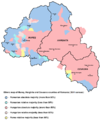



![Areas with ethnic Hungarian majorities in the neighboring countries of Hungary, according to László Sebők.[54]](http://upload.wikimedia.org/wikipedia/commons/thumb/5/51/MagyarsOutsideHungary.png/120px-MagyarsOutsideHungary.png)








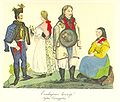



















![Gothic church of Kassa (today's Košice, Slovakia)[55][56]](http://upload.wikimedia.org/wikipedia/commons/thumb/d/da/Kosice_-_St._Elisabeth_Cathedral_1.JPG/120px-Kosice_-_St._Elisabeth_Cathedral_1.JPG)
